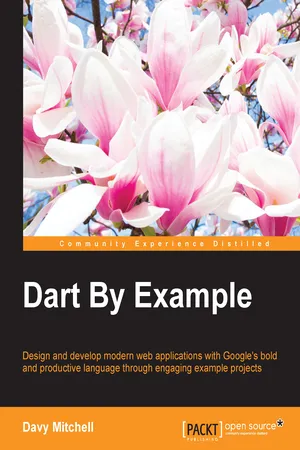
- 250 pages
- English
- ePUB (mobile friendly)
- Available on iOS & Android
Dart By Example
About This Book
Design and develop modern web applications with Google's bold and productive language through engaging example projects
About This Book
- Full of engaging and varied example projects to equip you to build your own web applications
- Learn the Dart language and key libraries
- Productively create fast and reliable web applications
Who This Book Is For
If you are a front- or back-end web developer who is looking to build complex full-featured web applications without the quagmire of disconnected JavaScript frameworks, this book is a practical walkthrough of substantial applications that will have you and your team coding Dart in a productive manner.
This book will give you a compiled, optional typed, scalable environment to rapidly develop applications. As Dart was designed to be familiar, any developer with even a small amount of knowledge of JavaScript or another programming language will be at home with the language immediately and will be coding quickly.
What You Will Learn
- Master the core Dart language, type system, and key development tools
- Connect to existing web services, process JSON, and create your own framework for the data display
- Run and debug the Dart server and web applications and compile them in JavaScript
- Handle form data and encryption
- Build and deploy server applications on the major OSes and implement the REST API
- Work with PostgreSQL—an industry standard relational database system
- Create robust applications with unit tests, documentation, and diagnostic logging
- Develop command-line applications, and explore the key data structures and libraries
In Detail
Designed to create next generation apps, Google's Dart offers a much more robust framework and also supersedes JavaScript in several aspects. Familiar yet innovative, compact yet scalable, it blows away the accumulated JavaScript legacy limitations. Dart was designed for great tool-ability and developer productivity, allowing you to create better application faster than before. Google chose it for their billion dollar advertising business and you have its power for your projects too.
This book will introduce you the Dart language starting from its conception to its current form, and where it headed is through engaging substantial practical projects. You will be taken through building typical applications and exploring the exciting new technologies of HTML5.
With example code projects such as a live data monitoring and viewing system, a blogging system, a slides presentation application, and more, then this book will walk you through step by step through building data-driven web applications with ease and speed.
Style and approach
A varied collection of compelling practical Dart projects that are developed progressively with full explanations of concepts and implementation. Each project introduces features of the language and environment, demonstrating how Dart can be used in rich structured web applications.
Frequently asked questions
Information
Dart By Example
Table of Contents
Table of contents
- Dart By Example